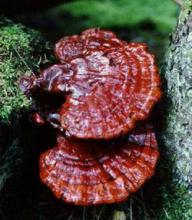
Ganoderma lucidum, Ganoderma tsugae
This King of Mushrooms is a Polypore, or shelf-mushroom. It grows almost exclusively on the trunks of dead or dying Hemlock trees in this hemisphere, and usually recurs year after year on the same stumps. It is beautiful, glossy-red and slightly curved at the margins, easy to spot once you know what you’re looking for. We usually harvest the mushrooms, gently cutting the stems without damaging the tree bark and the mycelium beneath, in late June / early July before they get too worm-infested. But since mushrooms fruit unpredictably (mostly based on the moisture around), take some of what you find when it looks good.
Elemental associations: Air
Phytochemistry: Polysaccharides, triterpenoids, fatty acids (Y. Murai)
Actions: Anti-allergenic, immunostimulant, hepato-protectant
Specific systems: Immune
This mushroom is another woodland being whose spirit I find to be very strong and projective. When I find it, spiraling up an old Hemlock, I can almost hear it whispering the stories of the woods to me, promising a return to a more balanced, peaceful life. It has an old and powerful spirit living in it, most definitely worthy of respect.
Taken internally, Reishi is an incredible re-aligner. It is used in anti-tumor protocols and helps support the system during chemotherapy, making it an excellent inclusion to any cancer protocol. It is being used experimentally for herbal treatment of HIV/AIDS as well as other auto-immune conditions such as lupus erythematosus.
In my personal experience, I have found no better remedy to treat asthmatic and allergic symptoms and chemical sensitivities. Even the most intense seasonal allergies and environmental sensitivities respond to this mushroom. It should always be considered as a first line of therapy in allergic complaints.
I believe Reishi accomplishes its wide and powerful actions by its metabolism in the liver, aligning the action of this organ so essential in all processes of regulation in the body. Further research on this mushroom’s effects on liver diseases such as hepatitis is warranted.
Indications: Cancer, chemical sensitivity, asthma and allergies of all types, liver disease
Contraindications: None
Preparation/Dosage: The mushroom should be dried to fully convert its active principles. A decoction can be made with 3 TBS per quart of water, reduced over 2-4 hours to a pint. A double-extracted tincture can be made by combining equal parts of a decoction with a tincture made from 70% alcohol, 20% glycerin, 10% water, at a 1:4 or 1:5. (The glycerin helps keep the polysaccharides emulsified – without it, the final product gets ‘clumpy’ and a bit slimy). Take 5-30 drops of this extract, once or twice a day.
